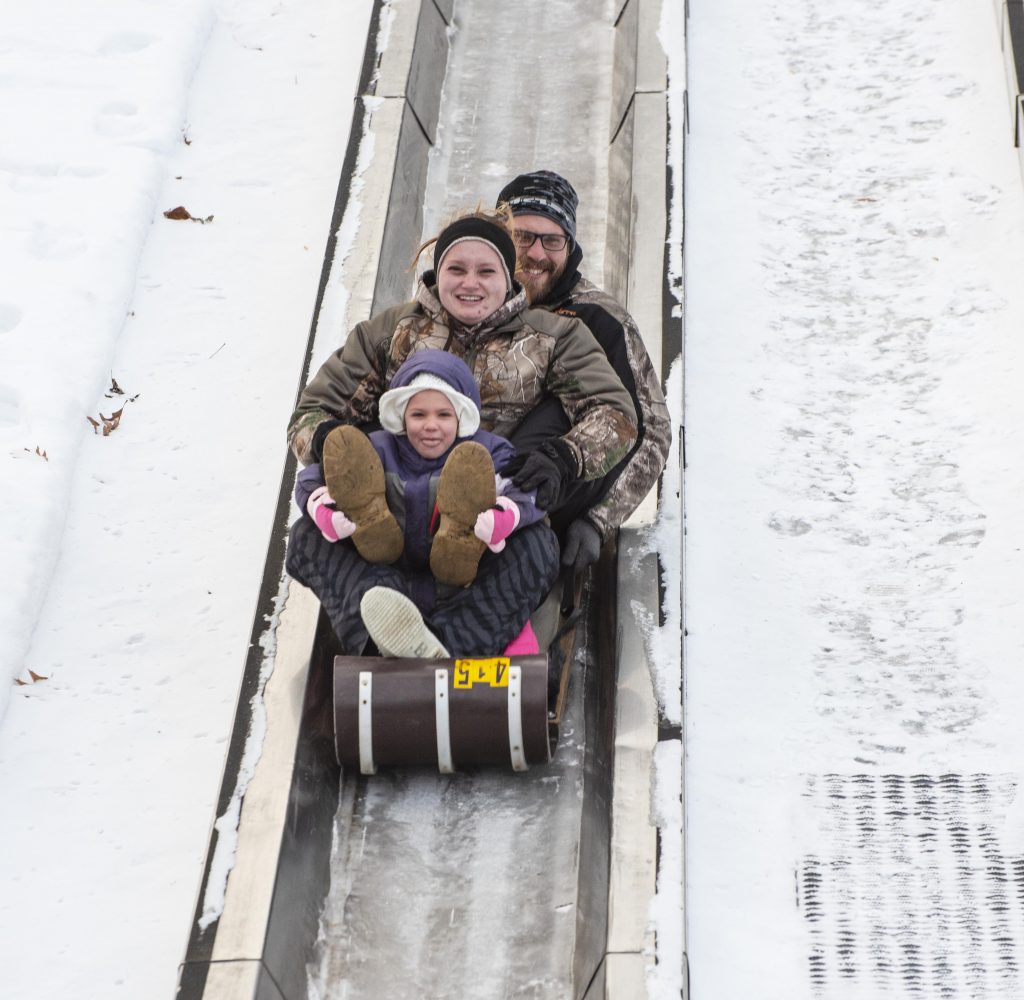
By Richard G. Biever
For Eddie Wise Jr., tobogganing at Pokagon State Park each winter is a family tradition with roots frozen in time.
The park’s famed icy toboggan run where he brings his kids, just as his parents brought him and his sisters when he was little, starts atop a steep-crested hill above the park’s Potawatomi Inn. From an additional 30-foot tower, the dual refrigerated runs drop, rise and drop again for a total fall of 90 vertical feet over a quarter mile. The 20-30 second thrill rides reach speeds of 30-40 mph.
“It’s a rush,” said Wise. “You don’t really get that big of hills around here with that long of a straightaway and up and down. It’s the better part of sledding.”
Wise should know. He grew up near the Steuben County state park where he’s been tobogganing ever since he can remember. The 33-year-old Wise and his wife, Brandi, both outdoor enthusiasts, take their children — Harlee, age 11, and Hawkin, 8 — tobogganing at Pokagon several times a season.
“It gets them into the outdoors and away from everything else,” Wise said. “Not a lot of kids do that anymore.”
Along with being outdoors and enjoying the thrill of the ride, Wise said he likes the memories tobogganing conjures and the nostalgic feel of the J-shaped wooden sleds. “It’s got its own unique throwback style.”
A glacial rush
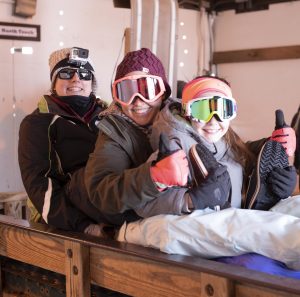
“Throwback” is the key word for tobogganing at Pokagon. Beginning its 81st season, the state park’s toboggan run itself dates back to the Great Depression and the Civilian Conservation Corps. But that “rush” of speed and adrenaline Wise noted is stirred from the steep hill that originated a little further back in time — about 10,000 years back — to when the last glacier stagnated and melted over Northeastern Indiana.
During the last Ice Age, unimaginably massive glaciers up to a mile high slowly flowed out of northern Canada and covered the northern two-thirds of Indiana. When they melted, they left their marks: most notably the Great Lakes. But they also left smaller landscape features, especially all across Northeastern Indiana.
The earth-moving and gouging glaciers gave Steuben County, for instance, more natural lakes — called “kettle lakes” — than any other county in the state. The state park is surrounded by two kettle lakes, Lake James and Snow Lake. The toboggan hill at Pokagon is a “kame” — a pile of rock and debris deposited by the melting glacier.
As meltwater flowed across the top of a glacier, it would gather debris imbedded in the ice. Through large cracks, the runoff would cascade like a waterfall leaving the debris at the bottom after the glacier melted away. The largest kame, and the highest point at Pokagon, is known as “Hell’s Point,” the pinnacle of a challenging hike at the park. Chain O’Lakes State Park in Noble County was also shaped by Ice Age formations.
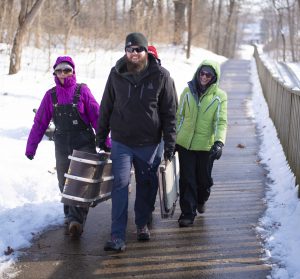
The many lakes in the northeast corner of the state make the area unique. They harbor wildlife and provide recreational opportunities. It’s a perfect place for a state park. Named for Leopold and Simon Pokagon, father and son leaders of the Potawatomi tribe of Native Americans who lived in the area in the 1800s, Pokagon State Park was one of the state’s earlier parks, dedicated in 1925.
The park and the Potawatomi Inn (built in 1927) provided a northern lake experience. “The state wanted us to be a year-round destination and thought people wouldn’t want to come here in the winter unless there was a warm place to stay,” said Nicky Ball, the Indiana Department of Natural Resources interpretive naturalist at Pokagon and the nearby Trine State Recreation Area.
Something fun to do in a Great Depression
While natural beauty, wildlife, and outdoor activities abound, it’s the man-made toboggan track that garners the most attention around Pokagon in winter. The run attracts some 90,000 visitors through the three-month season. Fortuitously, the attraction that iced the park’s reputation as a winter destination began simply as an amusement for the young men who built many of the park’s other lasting shelters and features.
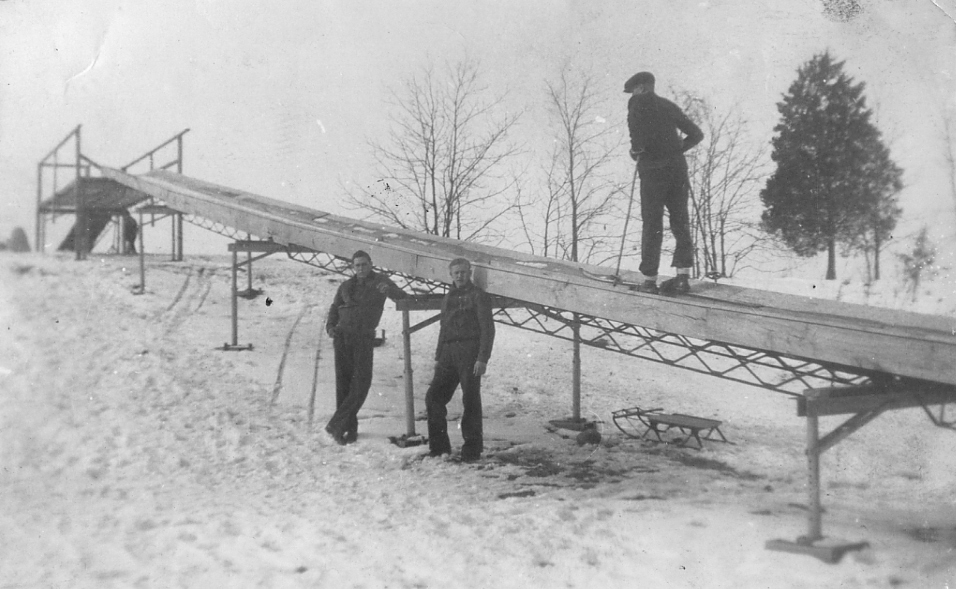
stand beside an early version of Pokagon State Park’s toboggan track, circa late 1930s-early 1940s. Photo courtesy of Pokagon State Park.
In October 1929, four years after Pokagon’s creation, the Great Depression began. One out of four Americans was unemployed. President Franklin Roosevelt came into office promising a “New Deal” for the American people. Five days after taking office in March 1933, FDR created the Civilian Conservation Corps to put unemployed, single young men to work. CCC projects focused on reclaiming land, enhancing natural areas, and building structures and infrastructure at national and state parks and other public places.
Company 556 of the CCC, which consisted of about 180 men, arrived at Pokagon in 1934. They first built their barracks, and then they began planting trees across the park’s mostly open terrain that had been farmland. In addition to many infrastructure and erosion control projects, the CCC built the classic structures found throughout the park. Works included the beaches, gatehouse, shelter houses, the original County Road Bridge, camping grounds, trails, the service building, the saddle barn, and more. The CCC’s structures and its beautiful masonry work on walls and large hearths, using timbers and glacial stones — all cut and laid by hand — are on the National Register of Historic Areas.
Behind their barracks, they saw the steep hill, the kame, and built a toboggan run. “It was their first winter here,” said Ball, “and the boys were just looking for something fun to do.”
The first wooden track they built, which would be enhanced with ice cut and hauled up from nearby Lake James, had a huge right-hand curve halfway down and would shoot the tobogganers out onto the frozen lake. The following year, the track was straightened to increase speed. In 1938, the park commercialized the operation. Company 556 erected a taller tower of about 20 feet, and the track opened to the public. A winter tradition at Pokagon was born.
The CCC added a second track in 1940. With the U.S. entry into World War II, the CCC disbanded soon after in 1942.
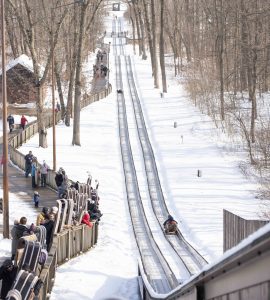
In 1971, Pokagon made the slide refrigerated which made it less dependent on freezing weather. In 1974, the current 30-foot tower replaced the aging CCC tower. Ten years later, the two tracks were renovated and a track-side warming center was built where tobogganers could buy snacks and hot chocolate, and sit before a fireplace and observation window.
Though it began out of happenstance, Pokagon’s toboggan run is something frequent glacial glider Wise said he thinks every Hoosier should experience. And it is one of only two such refrigerated facilities in the Midwest.
“It’s not a common thing, especially for people in Southern Indiana,” said Ball, talking about the lure of the wintry roller coaster. “We are ‘Up North’ to them, so the whole park has this Up North feel to it with the inn and the cabins and the lake. It feels like an old-fashioned kind of winter.”
RICHARD G. BIEVER is senior editor of Indiana Connection. Photos provided by Jaime Walker.
Rookie Tips
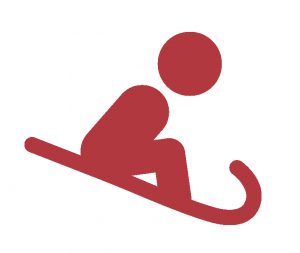
Eddie Wise Jr. has been tobogganing Pokagon since he was a tot. The 33-year-old outdoorsman offers tips for rookies:
Dress in layers
Tobogganers carrying the sled back up the hill can start working up a sweat even in cold weather. Layers will allow you to shed clothing when walking or add more while waiting your turn in line.
Have a ‘designated driver’ for a bigger tobogganing bargain
Visitors rent the toboggan by the hour, so the more trips down the run the bigger the value. To save time walking the toboggan back up the hill, have an extra buddy in a pickup truck waiting for your group at the bottom. When your group reaches the bottom, toss the toboggan in the back of the truck and drive back up to the top.
If you go to Pokagon State Park’s Toboggan
Pokagon State Park’s refrigerated toboggan opens for the season, with or without snow, at 10:30 a.m., Nov. 29. It operates through March 1, 2020.
Hours: Friday: 5:30-9 p.m.; Saturday: 10:30 a.m.-9 p.m.; Sunday: 11 a.m.-5 p.m. Hours are extended during school winter break. Pokagon is open on New Year’s Day, Martin Luther King Jr. Day and Presidents’ Day.
FEES AND INFO
Toboggan sled rental per hour: $13. Toboggan renters are guaranteed one ride per hour during peak times.
Park entrance fees: $7 in-state vehicles, $9 out-of-state vehicles, $2 a person on a bus. (Park hours: 7 a.m.-11 p.m.)
- Driver’s license is required as deposit, rents up to four toboggans.
- Must use park’s sleds. Rented on first-come, first-served basis.
- Maximum of four people per toboggan (no exceptions).
- Cash, check and Visa/MasterCard accepted.
- No all-day rentals.
- No group reservations or group rates.
- There are no specific age or height restrictions, but children must be able to understand and abide by rules.
- No cameras or video equipment are allowed on the ride.
- Toboggan will close if temperature drops to 0 degrees F or below.
- Warming Center concessions available (carry-in food prohibited).
Don’t forget the giveaway!
Visit www.indianaconnection.org/talk-to-us/contests to enter to win one of two Pokagon State Park prizes. Entry deadline: Nov. 30.


